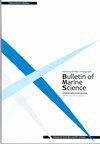Characterization of fish assemblages in mesophotic reefs of Cuba
IF 1.2
4区 地球科学
Q3 MARINE & FRESHWATER BIOLOGY
引用次数: 4
Abstract
Although mesophotic coral reef ecosystems (MCEs) are widespread and diverse, they remain largely unexplored. The Caribbean MCEs are among the most studied in the world, but detailed information regarding Cuban MCEs is limited. In this study we present the first analyses of the ichthyofauna of the Cuban MCEs based on data from a research cruise in June 2017. Forty-two sites were sampled around the Archipelago of Cuba using a Remotely Operated Vehicle at depths between 30 and 180 m. Overall, 151 species were observed, including 13 threatened species. Differences in ichthyofauna were observed between marine protected areas (MPAs) and unprotected areas, with greater abundances and species richness inside national parks. Invasive lionfish had greater abundances on the north coast, while the south coast had greater abundances and richness of threatened and commercially valuable species. A detailed analysis (Generalized Lineal Model) showed effects of depth, protection level, reef type (seamount or fringing reef), and region on abundance (as fish observed per minute), but no interaction between them. A transition was observed in the fish assemblages between the 30–60 m and 60–100 m depth ranges. Species abundance and richness decreased with increasing depth. The most represented families of commercial importance (Serranidae, Lutjanidae, and Carangidae) were well represented in the upper, middle, and lower areas of the MCEs, but dominated in deeper areas. The percentage of herbivores in the fish assemblage decreased with increasing depth, contrary to what was observed with piscivores and invertebrate feeders/piscivores. Twenty-seven functional groups were identified, with cryptic micro-invertivores and cryptic planktivores being the most abundant, while roving macro-invertivores and roving piscivores were the most functionally redundant. This research constitutes a valuable contribution to the study and management of ichthyofauna in Cuba and highlights the effectiveness of MPAs in the conservation of fish biodiversity.古巴中叶藻礁鱼类组合的特征
虽然中胚层珊瑚礁生态系统(MCEs)广泛而多样,但它们在很大程度上仍未被开发。加勒比mcce是世界上研究最多的国家之一,但关于古巴mcce的详细资料有限。在这项研究中,我们根据2017年6月一次研究巡航的数据,首次分析了古巴MCEs的鱼系。在古巴群岛周围的42个地点,使用远程操作车辆在30至180米的深度进行采样。共观察到151种,其中濒危物种13种。鱼类区系在海洋保护区与非保护区之间存在差异,国家公园内的鱼类区系丰度和物种丰富度更高。入侵狮子鱼在北海岸的丰度更高,而南海岸的受威胁物种和商业价值物种的丰度更高。详细分析(广义线性模型)表明,深度、保护水平、礁类型(海山或边缘礁)和区域对丰度(以每分钟观察到的鱼为单位)有影响,但它们之间没有相互作用。在30-60米和60-100米深度范围内观察到鱼类群落的过渡。物种丰度和丰富度随深度的增加而降低。具有重要商业价值的科(鹬科、鹬科和鹬科)在MCEs的上、中、下部均有较好的代表性,但在较深的区域占主导地位。草食动物在鱼类群落中的比例随着深度的增加而下降,这与鱼食性动物和无脊椎食性/鱼食性动物的情况相反。共鉴定出27个功能类群,其中隐蔽性微型无脊椎动物和隐蔽性浮游动物最为丰富,而游动性大型无脊椎动物和游动性鱼类功能最冗余。这项研究对古巴鱼系动物的研究和管理作出了宝贵贡献,并突出了海洋保护区在养护鱼类生物多样性方面的有效性。
本文章由计算机程序翻译,如有差异,请以英文原文为准。
求助全文
约1分钟内获得全文
求助全文
来源期刊

Bulletin of Marine Science
地学-海洋学
CiteScore
2.90
自引率
6.70%
发文量
25
审稿时长
6-12 weeks
期刊介绍:
The Bulletin of Marine Science is a hybrid open access journal dedicated to the dissemination of research dealing with the waters of the world’s oceans. All aspects of marine science are treated by the Bulletin of Marine Science, including papers in marine biology, biological oceanography, fisheries, marine policy, applied marine physics, marine geology and geophysics, marine and atmospheric chemistry, meteorology, and physical oceanography. In most regular issues the Bulletin features separate sections on new taxa, coral reefs, and novel research gear, instrument, device, or system with potential to advance marine research (“Research Tools in Marine Science”). Additionally, the Bulletin publishes informative stand-alone artwork with accompany text in its section "Portraits of Marine Science."
 求助内容:
求助内容: 应助结果提醒方式:
应助结果提醒方式:


